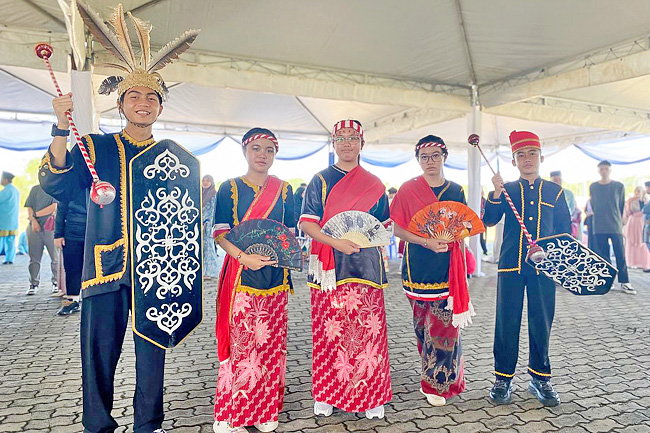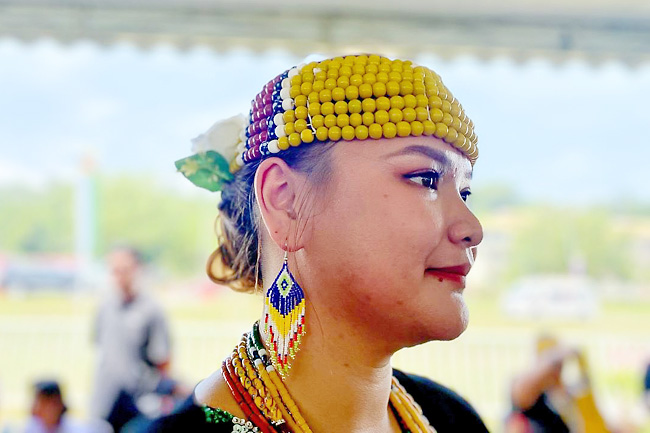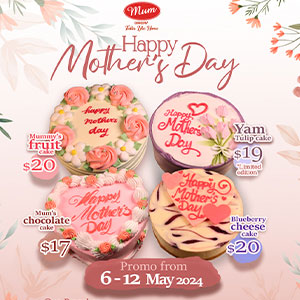Symbolising cultural pride, Brunei’s diverse ethnic groups hold their traditional costumes in the highest regard and proudly don them on special occasions, especially during weddings and other major events. One such significant event is the annual get-together ceremony, celebrated in all four districts.
During the grand gathering, each ethnic group receives a heartfelt invitation to showcase their unique customs and heritage.
The elderly in the community play a significant role in passing on the knowledge of tradition, especially in aspects of traditional costumes, to the younger generation, said Elia Nataliya binti Tong Sing, 20, who belongs to Brunei’s Murut ethnic group from the Temburong District.
“When I have my own children, I would pass it on to them so the next generation will know their roots and where we belong,” said Elia.
Temburong District’s Biring bin Batong, 69, from Kampong Parit shared that the Murut ethnic group hails from several villages in the district, including his own, Kampong Negalang, Kampong Senukoh and Kampong Selapon.
“The men in our ethnic group wear something we call bakad talun, a vest-like garment made out of wood bark such as timbaran,” explained Biring.





He said in the past, their parents imparted to them the art of harvesting materials to craft the garment, ensuring that the valuable aspect of their culture remains preserved.
“They passed down their knowledge so that it wouldn’t fade away with time. We learnt the skill of identifying the right trees amidst the dense jungles, carefully selecting the ones most suitable to create the bakad talun.”
Biring said that the age of the tree matters as it cannot be too young or too mature, as when the tree is too old, the material is harder to harvest, the bark more brittle, and if it’s too young, the bark will be too hard.
“You need to find a tree with a bark that is soft and pliable enough, but not fragile.”
He noted that the garment is also embroidered with some fabric and sewn using a thread, and nowadays, actual threads with different colours are used.
“In the past, the threads we used were from the timbaran tree as well. We rolled the tree’s fibres to make a thin rope.”
The patterns these garments are embroidered with can vary as these designs have existed within their tribe for generations, but a common motif is a leaf-like shape called pakis, inspired by the wild ferns that grow within the jungles.
Touching on the colours, Biring spoke about the red cloth wrapped around the head, called a sigar, reminiscent of the Malay dastar, albeit simpler, where the colour is important in their ethnic group and is more often worn by the menfolk. The men would also originally wear a red loincloth in the past, he said.
“It represents bravery and hearkens back to the tribe’s history of being warriors. For the men, the colour is red, and for the women, black.”
Rupan binti Kasim, who is in her mid-50s, and also from Temburong’s Murut ethnic group, spoke more about the Murut women’s traditional clothing worn during such events.
“Traditionally, the beads or bau were made of clay and given a circular shape. They are then woven onto the clothing by hand or made into jewellery called peta for the women to wear.
“The yellow on our clothes symbolises paddy as our people once traditionally worked on paddy fields. These are the traditional colours of our community.”
Rupan explained that although the headdress primarily serves as an ornamental accessory, it also carries the significant symbolism of a woman’s beauty.
The necklace they wear is referred to as a beret, and belts, crafted either from old coins known as beret riggit or from beads, are called beret bau. These two distinct types of belts add to the diversity and richness of their traditional attire.
Elia Nataliya, who accompanied Rupan during the interview, expressed concern about the possibility of other Murut people from her generation not supporting their cherished traditions.
Nevertheless, she empathised with the circumstances that might lead to this situation, acknowledging that there could be a lack of exposure and knowledge about their tribe among the younger generation.
“Luckily, more and more people are getting to know our traditions these days, and the younger generation has taken notice of it too, thanks to events such as this. I’m quite satisfied with that,” Elia said cheerfully.
In the Tutong District, the Bulletin spoke to 71-year-old Haji Md Zaki bin Abdullah Ringgit who manages the Kampong Ukong Village Consultative Council gandang group.
The Dusun people’s traditional costume, generally called Koubasanan, is made out of black velvet fabric with various decorations. Such as in Brunei’s Dusun ethnic group, the attire is lined with golden laces for both men and women, where the women would pair the top with a selendang skirt.
“The colours that are on our costumes represent a significant symbolism, and this type of attire is commonly worn during Dusun celebrations,” said Haji Md Zaki.
The traditional attire that stands out with a combination of red, white, and black is a feature beautifying the touch of clothing they showcase.
Red symbolises bravery or courage, white represents purity and black refers to the spirit of a warrior.
“We also have several types of headpieces we put on for different events, such as the asik.
There’s also the headpiece that’s made out of male Asian koel bird feathers and shrivelled mengkuang leaves,” the 71-year-old added.
As a representative of the Dusun ethnic group of Kampong Ukong, Haji Md Zaki expressed his immense pride that this heritage lives on, even though he feels that there is a lack in response from the younger generation within the ethnic group in their village.
“However, there are still Dusun youth from other villages who have actively adopted our traditional practices of costume and playing the gandang,” he said, sharing their village consultative council’s plans to carry out workshops in the future to preserve their traditions.
Ethnic costumes hold a significant cultural and social importance as they represent the rich diversity and heritage of different communities across the world.
The traditional attires serve as a vivid expression of identity, history and values to each ethnic group.
As a powerful symbol of pride and unity, it has the ability to foster a sense of belonging and shared heritage among individuals within the community, while playing a crucial role in preserving and passing down generations of customs and craftsmanship as they often incorporate intricate patterns, designs and techniques handed down through centuries.
In the context of the country, the Sultanate is home to a diverse and culturally rich society comprising of seven ethnic Malay groups.
Each group is crucial in shaping the nation’s cultural identity, bringing in its own distinct traditions, customs and languages contributing to the vibrant fabric of Brunei heritage.
The seven ethnic Malays are the Brunei Malays, Kedayan, Tutong, Belait, Dusun, Bisaya and Murut.
Despite their unique characteristics, they share a common bond through their Malay heritage and Islamic traditions.
Their harmonious co-existence has fostered a strong sense of unity and mutual respect, fostering a deep-rooted cultural heritage that continues to enrich the Brunei society.
The ethnic Malay groups not only preserve their ancestral customs but also actively contribute to the country’s progress and development, making Brunei a fascinating mosaic of cultural diversity.
Embracing and promoting the use of ethnic costumes not only celebrate cultural diversity, but also encourage intercultural understanding and appreciation.
They serve as a bridge that connects the past with the present, helping to keep traditional practices and stories alive while creating a beautiful tapestry of global cultural exchange and mutual respect. – Izah Azahari





